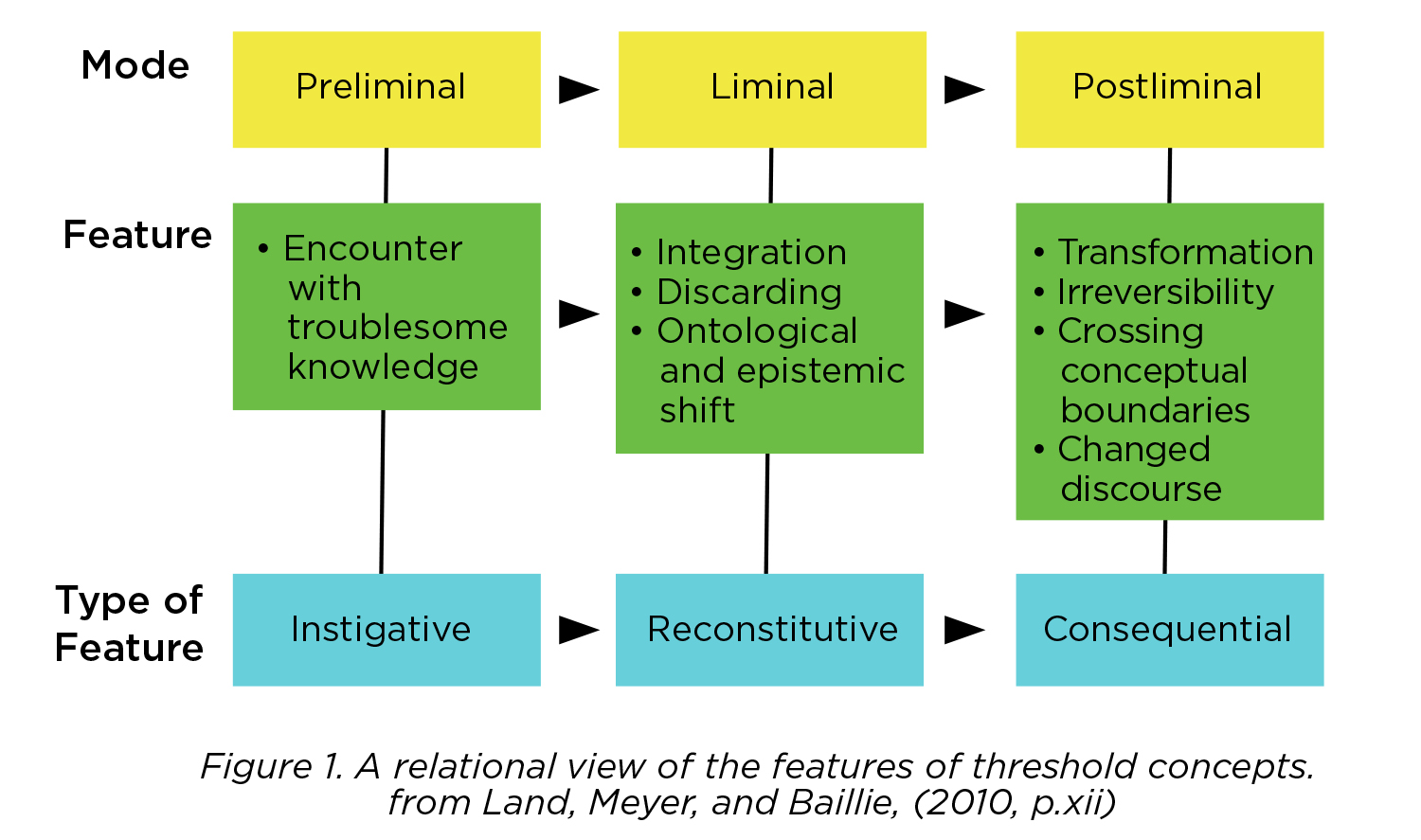Threshold Concepts
A concept is "..a unit of thought or element of knowledge that allows us to organize experience," (Donald, 2001, p. 9)
Threshold Concepts
- The core concepts and capabilities which the students MUST have to successfully transition to both subsequent courses and future employment
- First defined by Meyer and Land (2003) as being:
- Transformative (accessibility to the previously inaccessible - ways of thinking and functioning)
- A mandatory feature of threshold concepts
- Integrative (of previously perceived unrelated aspects)
- Are constructed and reconstituted rather than revelatory
- Troublesome (seemingly tacit, incoherent, counter-intuitive)
- "Real learning requires stepping into the unknown, which initiates a rupture in knowing. The interval of difficulty that follows exposure to existentially unfamiliar, educationally critical material can be understood as a response to that rupture," (Schwartzman, 2010, p. 38).
- Similar to Piaget's idea of adaptation (equilibration/disequilibration)
- Intellectual uncertainty
- Bounded (contextually and conceptually)
- Tend to be discipline specific (systemized, logical taxonomy, methods of validation)
Particular 'ways of knowing'
- Tend to be discipline specific (systemized, logical taxonomy, methods of validation)
- Once attained they are perhaps irreversible
- Transformative (accessibility to the previously inaccessible - ways of thinking and functioning)
- Considered critical for a student to progress, leading to previously inaccessible
ways of thinking and constructing knowledge (processing information in new ways)
- Are required to be able to progress to higher levels of functioning
- Are systems of ideas and ways of thinking that enable the construction of new knowledge (Perkins, 2006)

Threshold concepts are your critical course goals (student capabilities/behaviors) that guide your course development and decision-making.
Teacher Role
- Design courses that:
- Are not linear, but are recursive (repeated application and/or integration)
- Are process and context oriented
- Empower meta-cognition
- Utilize strategies such as concept mapping, What I Know so Far, Wordles, SWOT analysis
- Self-reflections and self-analyses
- Incorporate principles of Universal Design for Learning and Instruction
- Establish opportunities for small successes (progressions)
- Provide authentic experiences (via scaffolding)
- Engage and stimulate the thinking processes and behaviors (Donald, 2001) of:
- Description
- Selection
- Representation
- Inference
- Synthesis
- Verification
- Provide collaborative learning opportunities to rigorously examine concepts, perspectives, processes, relationships, and paradigms
References and Resources
- Donald, J. (2001). Learning to think: Disciplinary perspectives. San Francisco, CA: Jossey-Bass
- Flanagan, M. (n.d.). Threshold concepts: Undergraduate teaching, postgraduate training, professional development & school education. University College of London
- Felton, P. (June 20, 2013). Threshold concepts: Student & faculty perspectives. Center for Engaged Learning, Elon University
- Land, R., Meyer. J. & Baillie, C. (2010). Editors' preface. In R. Land, J. Meyer and C. Baillie, (Ed.s), Threshold concepts and transformational learning. (ix-xlii). Rotterdam, Netherlands: Sense Publishers
- Land, R., Meyer. J. & Smith, J. (2008).Threshold concepts within the disciplines. Rotterdam, The Netherlands: Sense Publishers
- Meyer, J. and Land, R. (2003). Threshold concepts and troublesome knowledge: Linkages to ways of thinking and practicing within the disciplines. ETL Occasional Report 4, May. Enhancing Teaching and Learning Environments in Undergraduate Courses. Edinburgh UK: Teaching and Learning Research Programme, University of Edinburgh
- Perkins, D. (2006). Constructivism and troublesome knowledge. In J. Meyer and R. Land, (Eds.). Overcoming barriers to student understanding: Threshold concepts and troublesome knowledge. (33-47). London: Routledge
- Schwartzman, L. (2010). Transcending disciplinary boundaries: A proposed theoretical foundation for threshold concepts. In R. Land, J. Meyer, and C. Baillie, (Ed.s), Threshold concepts and transformational learning. (21-44). Rotterdam, Netherlands: Sense Publishers
